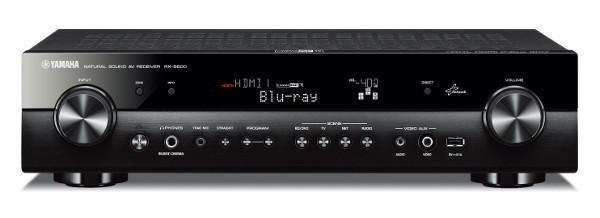Yamaha RX-S600 AV Receiver

AT A GLANCE
Plus
Modest but clean power
Slim form factor
Apple AirPlay
Minus
Not for demanding speakers
Bluetooth costs extra
THE VERDICT
This sensible little AVR has enough good-sounding power to run an efficient set of speakers or passive soundbar.
When is less more? Is there ever a time when you’d rather have less power? Let me rephrase that: Is there ever a time when you’d like to have less power running smaller and/or more efficient speakers? The answer in this instance may be yes.
There’s no point in paying a four-figure sum for a receiver if your power and feature needs are minimal. What’s important is that the power is clean and appropriate to the load, so that the speakers will sound good. This scenario may be anathema to the audiophile who wants a muscle amp to exert an iron grip on some challenging but rewarding speakers. However, the same scenario may get a friendlier reception from the person living in a small mountain cabin powered by solar panels. Our mountain dweller wouldn’t want the surround system to be too loud, or to compete for available electrons with the lights, the Energy Star-certified TV, the satellite dish, the computer, and the mini-fridge. And of course there are always folks who, out of either necessity or public-spiritedness, want to shave their power use to the absolute minimum.
Quality, Not Quantity
Yamaha bids to provide a modest amount of high-quality power with the RX-S600. Just over 4 inches tall, this small-form-factor receiver is rated at 55 watts into 8 ohms with two channels driven, or 60 into 6 ohms, or 95 with just one channel running. It won’t be the best choice to run demanding speakers in large rooms but is likely just fine for limited-bass satellites, and in smaller rooms, full-range speakers with efficiency ratings around 90 decibels. Note that many manufacturers consider 100 watts the minimum figure suitable for a spec sheet, even if the product falls far short; I’ll go out on a limb and guess that Yamaha’s spec is close to the truth. See our Test Bench measurements for something better than a guess.
Also note that there are five amp channels and five sets of binding-post speaker terminals. This is not a seven-channel receiver, and it will not run back-surround, height, or width channels. No loss, in my opinion. However, if you don’t mind losing the surround channels, you can use the last pair of amp channels for a second zone or to biamplify the front left and right channels.
This receiver is an inch or two shorter than the norm, which may alone be an attraction for some aesthetically minded buyers. The not-so-tall front panel is relatively simple, with the usual buttons, jacks, and knobs. Four buttons are dedicated to Yamaha’s Scene controls, each of which combines an input with appropriate settings for one-touch selection. If those don’t serve your needs, you can spin the input knob and use the Program forward/back buttons to cycle among listening modes.

The back panel sports six HDMI jacks, including one with ARC (the Audio Return Channel), which allows bidirectional signals to run between receiver and TV, so the receiver can play audio from your TV—something you may wish to do if you use your Smart TV to stream Netflix or other services. Also among the HDMI jacks is one with MHL, for connection of an Android device. This jack might have been handier on the front panel, but never mind. The front does have a USB jack “made for” iPhone, iPad, and iPod.
Every receiver comes with a performance-related slogan, and in this case it’s Total Purity Concept. That might mean someone has defined high standards and is working fervently to uphold them. Or that someone did that years ago, but things have slipped. Or that someone simply needed a marketing buzzphrase asserting that Our sound is the best.
For this Total Purity Concept receiver, Yamaha has “meticulously selected and custom designed” the power transformers and anti-vibration heatsink (solid-state electronics can sometimes be microphonic and do occasionally convert vibrations into signals). Some build-quality features are impossible to fake, such as the rigid aluminum (as opposed to plastic) front panel. Independent power supplies for analog and digital circuits—not something you’ll find in every receiver at this price point—minimize their ability to pollute one another and confirm Yamaha’s higher-end aspirations.
Some receivers in this price range are overachievers, with feature rosters covering every network audio goody under the sun. This model has a few of those attractions, starting with Apple AirPlay wireless connectivity, which sends a high-quality signal from your iOS mobile device to the receiver through your home network. Bluetooth isn’t provided, but you may add the optional YBA-11 adapter for $70. Generic Bluetooth kits often cost half as much—but the Yamaha version is powered by a special port on the back panel, making for a neater installation.
As an alternative, that port can power the YWA-10 Wi-Fi adapter ($100) if your equipment rack isn’t within easy reach of an Ethernet connection. Other network audio features include Internet radio, personalized Pandora audio streaming, and DLNA access to media stored on PCs or devices running DLNA apps. In addition to a decent but unexceptional remote control, Yamaha offers an AV Controller app for both Android and iOS phones and tablets. You can also use a computer or tablet Web browser to control the receiver through your home network.
Although the receiver’s dynamic range control is generic—no fancy Dolby Volume, THX Loudness Plus, or Audyssey Dynamic EQ/Volume listening modes here—it does function with lossless soundtracks. In the early days of lossless surround, generic DRCs often functioned only with old-school Dolby Digital and DTS, but fortunately those days are waning.
- Log in or register to post comments





































































